Hi everyone, Michael here to take a look at the evolution of the rules for vehicles in the warhammer universe. For more reviews, analyses and battle reports, check out the Tactics Corner.
This series of articles will take a look at how the rules have changed over the time I have been playing 40k (from 3rd edition to the current 7th edition rules). These are obviously my opinions on how various aspects of the game has changed over the years.
Vehicles are an iconic part of the 40k setting; it would be hard to imagine the battlefield without the Leman Russ, trundling along to support the stalwart Imperial Guard or the sleek, deadly skimmers of the Eldar race. The rules for vehicles have seen a lot of changes since their first introduction in Rogue Trader many, many years ago.
Obviously, there is a ton of material to look at in the rules for vehicles and I am not going to look over the minutia of all the rules there have been. Instead, I want to look at general trends in the vehicle rules for each edition. These will focus on vehicles in the movement phase, shooting phase, the assault phase and how vehicles are damaged.
I will be focusing on tanks as one of the most common vehicle types. The rules for skimmers and other vehicles will be mentioned where appropriate, but I will not be looking at walkers as these are a very different entity. This article will also not focus on the changes to transport vehicles. These have seen much evolution over the course of several editions and will be looked at in their own article.
Second Edition (1993-1998)- Complex Machines
My indoctrination into Warhammer 40,000 began with the release of 3rd edition. While I did not play the game in 2nd edition, the dataslate rules for many of the vehicles in the 40k universe were published in the pages of White Dwarf, giving me a tantalising glimpse of how they operated in the game.
Vehicles in 2nd edition were much more complicated beasts than we are used to, though there are still similarities to the current vehicle rules.
Each vehicle came with its own datasheet, detailing the stats of the vehicle and its damage tables.
Vehicles had three different speeds; slow speed, combat speed and fast speed and some were able to move much faster than their equivalents in the current edition. They had Front and Side/Rear armour values, though these were generally much higher values, given the armour penetration properties of weapons back in 2nd edition. For example, the Eldar Fire Prism had front, side and rear armour of 18 on its Hull (a much higher value than anything currently available). Armour penetration in weapons were also more unusual in second edition 40k; the assault cannon had an armour penetration of D6+D10+8. Given the current state of the rules, it is hard to imagine rolling anything other than a D6 for values in 40k, never mind having to roll multiple different sided die to get the result.
One of the major complexities of vehicles in 40k in second edition was having to roll to see which location was damaged with a shot and then to roll on different damage tables to see what effect the shot had. Each vehicle had its own unique damage table that applied when it took enemy fire. As can be seen in the pictures above, this could quickly lead to a situation where much more note taking was required for each individual vehicle to keep a record of the various damage effects that could occur.
Another interesting feature was that the crew of open-topped vehicles could be affected by enemy fire. In fact, taking out the vehicle’s crew could be an easier method of stopping a tank, as the crew were generally much easier to kill than the vehicle itself. If the driver of a vehicle was killed, it would generally go out of control for the rest of the game, moving randomly around the table until it collided with another vehicle/piece of terrain or left the board entirely.
Third Edition (1998-2004)- Streamlining the Rules
The release of 3rd edition came with a dramatic overhaul of the rules for 40k, simplifying many of the core rules that had been in 2nd edition.
“The vehicle rules in the new 40K have undergone a major over-haul, as they were undoubtedly the weakest element in the old version of the game“- Jervis Johnson, White Dwarf 226.
Armoured Up
Armour values became standardised in a range of 10-14 for all vehicles, and they were given separate Front, Side and Rear armour values. The rules for penetrating the armour of vehicles were also simplified; you simply rolled a D6 and added it to the strength of the weapon. No longer did each individual weapon have a complex formula for determining its armour penetration power. Vehicle movement also became standardised, with all tanks being able to move up to 12″ in the movement phase (24″ in the case of Fast vehicles).
One of the major benefits of vehicles in 40k is the increased volume of weaponry they can carry and their increased durability. The new movement rules made vehicles twice as fast as infantry in the game, but this additional movement came at the expense of a tank’s firepower. Vehicles that did not move in the movement phase could fire all their weapons in the shooting phase. Vehicles that moved up to 6″ could fire a single weapon. Vehicles moving over 6″ could not fire any weapons. A vehicle firing an Ordnance weapon could do nothing else that turn.
These rules made vehicles very powerful if they remained stationary, able to fire to full effect. If the vehicle moved, then they had to balance the trade off between mobility and firepower. In third edition, many vehicles remained static to use their firepower to full effect, especially those equipped with multiple weapons or ordnance weapons.
Bringing Them Down
Another big change brought about by 3rd edition was that all the individual damage tables from the various different sections of the different vehicles were removed, with vehicle damage now being resolved using three common damage tables; glancing hits, penetrating hits and ordnance hits.
These tables introduced the vehicle damage that we still use today- crew stunned, crew shaken, weapon destroyed, immobilised and vehicle destroyed results would serve to incapacitate vehicles by reducing their mobility and/or firepower.
Glancing hits were introduced to represent lesser blows to a vehicle when the armour value was equalled by the firing weapon. These provided a 1 in 6 chance of destroying the vehicle. Penetrating hits (when the armour penetration beats the armour value of the vehicle) were much more powerful, providing a 50% chance that the shot would destroy the vehicle. Ordnance weapons had their own table, providing more powerful damage results such as Vehicle Annihilated, which would have dramatic impact on any passengers in the tank.
Continuing the theme of third edition, this was a significant simplification of the vehicle rules, designed to make them more uniform across the game. You would no longer need to carry data sheets for all the different vehicles in your army as the common damage tables applied to all tanks in the game, as well as simplifying the rules for moving and shooting with vehicles and armour penetration for the different weapons in the game.
One of the disadvantages of this edition was that multiples of the same result on the damage tables incurred no penalty. For example, if your vehicle was immobilised and another penetrating hit resulted in a second immobilised result, then no further effect took place. This meant that tanks could suffer multiple glancing or penetrating hits that had no result on the capability of the vehicle, leading to frustration for your opponent and a need to expend more firepower to deal with problem tanks.
Cover was also useful for vehicles, automatically downgrading penetrating hits to glancing hits, increasing the durability of vehicles even more.
Vehicles in Combat
If you could not shoot your opponent’s vehicles to death, the other option was to try and take them out in combat.
How easy vehicles were to hit in combat depended on how fast they moved in the last turn. A stationary vehicle was automatically hit in combat, vehicles moving up to 6″ were hit on a 4+, whereas vehicles moving over 6″ or that were skimmers could only be hit on a 6. This made it very difficult for some infantry to take out certain vehicles as they could not muster up enough hits in combat to take them out.
Another big change to 40k in 3rd edition was that grenades were now exclusively used in the realms of combat. Frag grenades now helped assaulting units, while krak grenades and meltabombs were used to deal with vehicles in combat. These grenades were pretty much essential when it came to dealing with tanks, as very few infantry could even damage vehicles without the use of grenades or specialist equipment such as power fists, as in third edition, attacks in combat were carried out against the armour that you were facing.
Most commonly, infantry would be assaulting the front of a vehicle and only sergeants with power fists or specialist troops stood a chance of damaging it. In third edition it was very easy for vehicles to “run away” from infantry, moving to prevent them from getting to the weaker side or rear armour of the vehicle.
Going Forwards
Third edition set the stage for the vehicle rules in 40k, the theme of which can be seen to this day. The rules were greatly simplified, but vehicles still remained very powerful on the battlefield, able to bring the biggest guns to bear in the form of Ordnance weaponry and able to fire effectively, even on the move (though all those sponsons on the Leman Russ were a big waste of time).
It was common to see tanks hidden at the back of the field in cover, firing a multitude of heavy weapons at the enemy and forcing them to cross the battlefield to deal with them or to outshoot them with their own long-ranged firepower.
Third edition was also the era of the incredibly powerful “Rhino Rush”, with assault armies being king of the hill. This aspect of the vehicle rules will be covered in more detail in the next article on transport vehicles.
Fourth Edition (2004-2008)- Getting all Defensive
After 6 years of Rhino Rush and tanks as static firepower machines, 4th edition was launched with a brand new set of rules for vehicles.
“After the Assault phase, the Vehicle rules have the most modifications. From being static bunkers in third edition, tanks can now advance on the enemy lines, firing as they go“- Pete Haines, White Dwarf 297.
Moving and Shooting
As mentioned above, vehicles became a lot more mobile in the new edition of the rules, while maintaining a decent level of firepower.
A key concept in this edition was the introduction of Defensive (S6 and below) and Main weapons (S7 and above). If stationary, a vehicle could fire all defensive and main weapons. If it moved up to 6″, it could fire a single main weapon and all defensive weapons or could fire a single ordnance weapon. Vehicles moving over 6″ could not fire any weapons. Fast vehicles were able to fire more weaponry on the move, making them much more mobile while maintaining a decent rate of fire.
Another benefit of vehicles in 4th edition was that they were not restricted to firing at the closest target. Under this version of the rules, units were required to fire at the closest enemy unit unless they passed a leadership test. Vehicles were able to circumvent this requirement and choose their target at will.
The new vehicle rules were great in allowing tanks to move and fire at the same time, adding a new level of mobility to the game. Being able to move and fire Ordnance weapons was also a boon for the tanks of the Imperial Guard as they were no longer restricted to being merely static engines of destruction, but could actually move and react to the battle as it unfolded.
A Stunning Change
There was also some modification to the damage tables in 4th edition. Immobilised and Weapon Destroyed results were swapped on the table, with Immobilisation of vehicles occurring on the higher roll now.
Weapons Destroyed results now only affected weapons of S4 or higher. This didn’t have too much effect on most vehicles, but stopped players using weaponry such as lasgun arrays to “soak up” weapons damaged results.
Another big change was that penetrating hits automatically caused a Crew Stunned result in addition to any other result on the table. This served to hinder the firepower of enemy tanks when they were penetrated, as well as hindering their mobility (unless they had some form of Extra Armour-type upgrade).
Also, for the first time, additional results on the table started to have an effect. For example, if you rolled a Weapons Destroyed result on the damage table, but had no more weapons on your tank, it would become an immobilised result instead (and vice versa). A vehicle that had no weapons and was immobilised that suffered another such result was instead destroyed and removed from play. This was a good change to the vehicle rules, removing the frustration of rolling the same result multiple times to no effect.
The effect of cover in protecting vehicles also changed. Penetrating hits were no longer automatically downgraded to glancing hits when in cover, but only on a roll of a 4+.
Fourth edition was also the first time that the AP value of weaponry became important in the context of vehicles. AP1 weapons automatically upgraded glancing hits to penetrating hits, whereas AP- weapons could only cause glancing hits. This change meant that Melta weaponry was great for its intended role in taking out vehicles, with a 50% chance of destroying a vehicle with each glancing/penetrating hit. It also prevented high strength, anti-infantry weaponry such as the multi-laser from easily destroying vehicles.
This new edition of 40k gave tanks a greater degree of mobility and firepower on the move. This increased ability on the battlefield was tempered by making vehicles slightly easier to destroy by making stacked weapons destroyed/immobilised results more hazardous to vehicles and reducing the effectiveness of cover in protecting vehicles.
Fifth Edition (2008-2012)- One Table to Rule Them All
Fifth edition brought with it another big change to the vehicle rules for tanks in 40k. The three previous vehicle damage tables were condensed into a single table. Vehicles gained a measure of increased durability under the new system, with only a 1 in 3 chance of destroying a vehicle when rolling on the table, compared to a 50% chance of a penetrating hit destroying a vehicle under 3rd and 4th edition.
Modifying the Damage
With only one table to now cover all damage to a vehicle, the effects of glancing and penetrating hits, different weapon types and different vehicle types were covered by applying penalties or bonuses to the roll on the table.
Glancing hits now incurred a -2 penalty to the roll on the table, making immobilisation the highest damage result that could occur. The practical effect of this was that it was now impossible to destroy a vehicle with a glancing hit, without using some highly damaging weaponry or firing at an open-topped vehicle. This helped to further improve the durability of vehicles in 5th edition.
The effect of weapons with different AP values was also carried on into 5th edition; AP1 weapons added 1 to the roll on the table, giving a 1 in 2 chance that a penetrating hit from these weapons would destroy a vehicle. On the other hand, AP- weapons subtracted one from the roll on the table, making it more difficult for these weapons to outright destroy a vehicle. Open-topped vehicles also added one to the roll on the table, making these vehicles more vulnerable to enemy firepower.
The effect of cover was also modified, giving obscured vehicles a cover save. This was a change in that glancing or penetrating hits could be completely negated by cover, rather than simply being downgraded as in previous editions.
The rules for vehicles moving and shooting were largely unchanged between 4th and 5th edition. The number of weapons a vehicle could fire was still dependent on how far it had moved, and weapons were still separated into Defensive and Main weapons. With the Ordnance table now removed, the high power of these weapons was represented by allowing the player to roll two dice on the damage table and picking the highest result, giving a greater chance of destroying a vehicle or causing more extensive damage.
Hitting Hard
The increased durability of vehicles against shooting was tempered by increasing their vulnerability to assault. New to 5th edition, all hits in combat against vehicles used the rear armour value (unless it was a walker).
This was a really good change to the vehicle rules, in my opinion. This change made tanks much more vulnerable to infantry in combat, as S4 troops could now damage most vehicles in combat without having to manoeuvre to the rear of the enemy vehicle.
Vehicles were now no longer impervious to most infantry in the game and now required support from their own troops to prevent them being overrun and destroyed.
Hard to Beat
Fifth edition continued the trend of increasing durability of vehicles, with the chances of a penetrating hit destroying a vehicle decreasing and a glancing hit being unable to destroy a vehicle under normal circumstances.
My strongest memories of vehicles in 5th edition were my Ork Killa Kans. I used to run them in front of a mob of 30 Slugga Boyz, led by a Big Mek with a Kustom Force Field. This provided the Kans with a 4+ cover save, which added to the increased durability of walkers and made the Kans a very tough prospect to defeat. The three Kans won me many games, able to take out the toughest of foes or vehicles, with a large mob behind them to take on anything they couldn’t deal with.
Sixth Edition (2012-2014)- Hull-a-palooza
The biggest development to the vehicle rules for this new edition of the 40k rules was the introduction of Hull Points and Snap Shots.
Each vehicle was now given a number of Hull Points to represent damage that could be taken before the vehicle was destroyed. Most tanks were given 3 hull points as standard, with heavy duty vehicles such as the Land Raider getting 4 hull points and light skimmers and support vehicles only having 2 hull points each. I think that the concept of hull points was introduced to help make vehicles much more active before they were destroyed.
Previously, a glancing hit would prevent a vehicle from firing in the next shooting phase at the minimum, but could potentially cause weapon damage or immobilisation. Since 6th edition, a glancing hit would remove a hull point from the vehicle, but cause no further damage or penalty. This meant that a vehicle could still move and fire to full effect, even though it had been damaged. This change to the vehicle rules meant that glancing hits had little effect on a tank until they had suffered enough damage to completely remove all their hull points and wreck them. Penetrating hits also removed a hull point as well as rolling on the damage table for an additional effect.
The damage table itself also saw some modification from previous editions. The biggest difference is that the chance of destroying a vehicle with a penetrating hit had decreased from a 1 in 3 chance in 5th edition to only a 1 in 6 chance in 6th edition. While it may seem that the durability of vehicles had doubled in 6th edition, some vehicles became easier to destroy through depletion of hull points by “glancing to death”- a little bit of a misnomer as both glancing and penetrating hits removed hull points. For example, under the previous editions of the rules it could potentially take upwards of 6 glancing/penetrating hits to destroy a sponson-equipped Leman Russ (4 weapon destroyed results, immobilised result and another hit to destroy) if you were unlucky enough to not get the Vehicle Destroyed result on the table. Now, a combination of 3 glancing hits or penetrating hits will wreck most tanks outright. Rolling duplicates on the table also results in the loss of a further hull point, making vehicles easier to destroy.
This change made it feel like your firepower against enemy tanks is actually achieving something, bringing them closer to being destroyed rather than just rolling countless Crew Shaken results that limited the firepower of the enemy tank, but did little else.
Snap Decisions
Another big change for 6th edition was the introduction of Snap Shots to the main 40k rules. While this served to give infantry some semblance of additional firepower on the move, with heavy weapons being allowed to hit on a 6, it also allowed the firepower of vehicles to increase slightly compared to previous editions.
A Crew Stunned or Crew Shaken result on the damage table now forced a vehicle to fire Snap Shots rather than being unable to fire at all. While this prevented the most damaging Ordnance blast weapons from firing in the shooting phase, vehicles with a high volume of fire could still potentially put out some damaging shooting (especially if they had access to some form of twin-linked fire).
This slight upgrade to the firepower of vehicles may have been due to making the task of destroying vehicles slightly easier in 6th edition thanks to the introduction of hull points.
Get Moving
There were also minor changes to the rules for vehicle movement and shooting in 6th edition.
For the first time, vehicles were able to fire other weapons in addition to ordnance weapons, but the other weapons were forced to fire snap shots.
On a side note, it annoyed me that the Leman Russ, the stalwart of the Imperial Guard, lost its lumbering behemoth rule in place of simply being classified as Heavy. This meant that the Russ had to snap fire its other weapons when firing the main ordnance cannon, rather than being able to fire to full effect under the previous rules. This made it annoying for all us Guard players that had their sponsons glued on.
Vehicles also gained an extra measure of mobility in 6th edition by being able to move Flat Out, essentially a run move for vehicles. By forgoing shooting, a tank could move an additional 6″ in the shooting phase- useful for getting your assault troops to the enemy faster or for grabbing objectives late in the game.
Following on from the previous edition, vehicles now became even more vulnerable to infantry in assault. Moving vehicles were treated as WS1 in combat, with vehicles that did not move in the last turn being hit automatically in combat. Whereas before, vehicles were hit on a 4+ in combat (or on a 6 if moving fast enough or a skimmer), mobile vehicles would generally now be hit on a 3+. As well as continuing to be hit on the Rear armour in combat, S4 infantry now had a greater chance of hitting and wrecking vehicles in combat, even without specialist grenades or weapons.
Another big change to the rules for vehicles in 6th edition was that the rules for flyers were now included in the rulebook. Previously, these complex machines had been the purview of apocalypse games or used in supplement books, they now had a place in the general rules alongside all the other vehicle types in the game, leading them to become more mainstream for inclusion in regular games of 40k.
An Odd Situation
The release of 6th edition 40k marked another milestone in the development of the vehicle rules. The introduction of Hull Points appeared to make vehicles easier to wreck, while also changing the vehicle damage table to decrease the chance of a penetrating hit outright destroying a tank.
The trend of making it easier for infantry to potentially destroy vehicles in an assault also continued, with vehicles being easier to hit in combat in this edition.
The complexity of vehicle types was increased with the introduction of flyers to the realm of mainstream 40k, a trend that was set to continue with the release of the current edition.
Seventh Edition (2014 onwards)- Superheavy Slam
Perhaps the biggest shake up to 7th edition and the cause of consternation for many 40k players was the introduction of superheavy vehicles into the main rulebook.
For many years, these gargantuan vehicles had remained in the realm of Apocalypse games where you were expecting droves of models to be removed each turn and had your own stratagems for dealing with Superheavies, such as hitting them with Vortex Grenades. Superheavy vehicles had slowly been creeping into 40k with the release of the Escalation expansion, allowing their fielding in regular games of 40k, and with the very popular release of the Imperial Knight, providing an extremely powerful new unit for the armies of the Imperium to use.
With 7th edition, we also began to see the first creeping of Destroyer weaponry into “regular” units in 40k, perhaps introduced to deal with the increased fielding of superheavies.
Rolling a 7!
Perhaps fittingly, seventh edition saw the vehicle damage table turned all the way up to 7 for the first time. This change meant that it was now impossible to “one-shot” a vehicle to destroy it and take it out of the game without using some form of high AP weaponry or having a more vulnerable vehicle (open-topped). This change continued the trend of increasing vehicle durability by making it flat out impossible to blow up a tank without using AP 1 or AP 2 weaponry, meaning the good old anti-tank Lascannon and Melta weaponry were still great for dealing with enemy armour. For a lot of other weapons though, this meant gradually stripping the hull points until you could wreck the tank through attrition.
Combat Effective
Another minor change to the rules for vehicles was that they were no longer hit automatically in combat unless they were immobilised. Whereas before, a vehicle had to move to be WS1 in combat, all vehicles were now WS1 in combat, unless previously immobilised. This was a minor, but significant change to the way tanks now worked in combat. Attacking infantry could be expected to miss with approximately one third of their attacks now, rather than getting all automatic hits- a decent increase to the durability of vehicles in combat.
The popularity of Grav weaponry has also hindered vehicles in 6th and 7th edition. The risk of a vehicle being immobilised by a single successful “wound” from Grav weapons makes taking vehicles a risky prospect in many armies.
Moving Forwards
So that is a brief history of how the rules for vehicles have evolved in 40k to the current state of the rules in 7th edition. To my mind, vehicles still remain an effective tool on the battlefield, able to carry out roles that infantry units simply cannot in the current game.
It is tough to see how vehicles may continue to develop in future editions. The general trend appears to be to make vehicles tougher to enemy firepower while making them more vulnerable to assault.
I quite like the current state of the vehicle rules for 40k. They are tough machines, able to put out a lot of firepower on the move, while also being generally tough for standard infantry to deal with. It is hard to envision how they could be made more durable in a new edition than their current level. The only thing I could think of would be adding some sort of inherent save that could not be negated, similar to the Necron’s re-animation roll, but I’m not sure this would be the best move forward for them.
I also like how vehicles have been made more vulnerable to assaults in each subsequent edition, with units getting to hit the rear armour in combat and vehicles being easy to hit in combat. This means that your tanks generally require some infantry support to stop them being mobbed and destroyed with little effort. One change I would like to see going forward is that infantry could always glance a vehicle on a roll of a 6 in combat. This would make tanks and other vehicles particularly vulnerable to all infantry units. It is annoying when your strength 3 troops can do nothing to take down the enemy tanks when your anti-armour firepower is just not getting the job done. Imagine how scary a mob of Guardsmen would be to the enemy armour, knowing that even the lowliest grunt had the potential to take them out.
I hope you have enjoyed this look at the evolution of vehicles in 40k, an iconic part of the Warhammer universe. The next article will look at how the rules for transport vehicles has changed over the various editions, of which there is a lot to talk about and I think it is interesting to see how the rules have evolved over time.
So now it is over to you- what has been your favourite edition of the vehicle rules so far? Are there any rules you would like to see brought back or rules you wish you could remove from the current edition?
And as always, Frontline Gaming sells Games Workshop product at up to 25% off of retail, every day!
You can also pick up some cheap models in our Second Hand Shop. Some of these gems are quite rare, sometimes they’re fully painted!



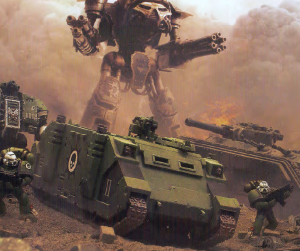
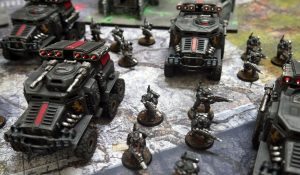
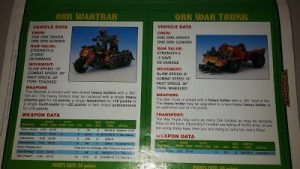
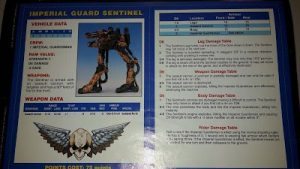
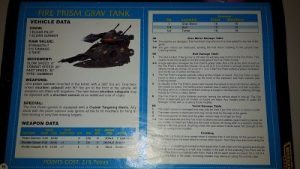
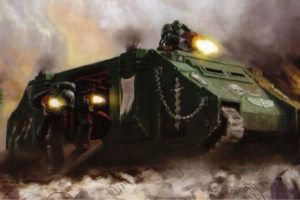
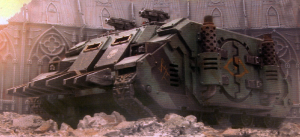
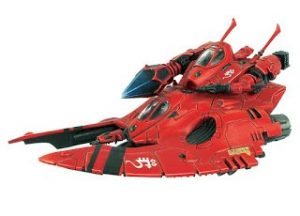
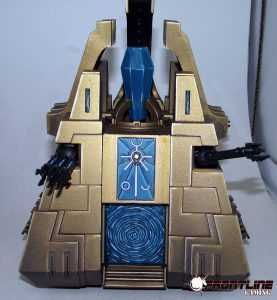
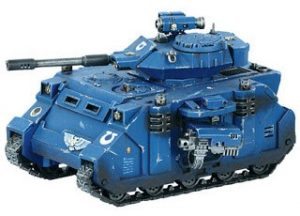
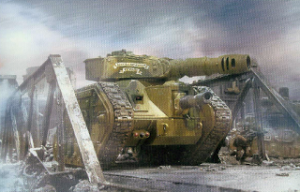
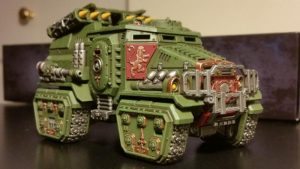
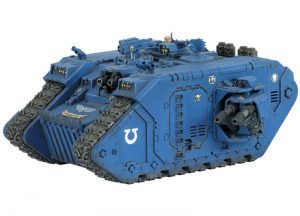
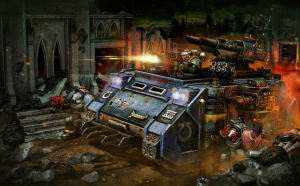
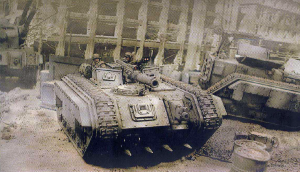
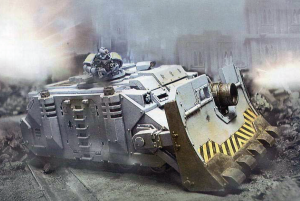
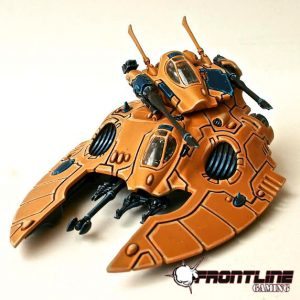
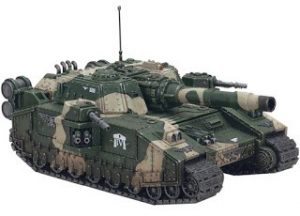
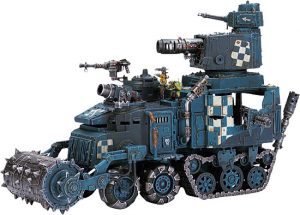
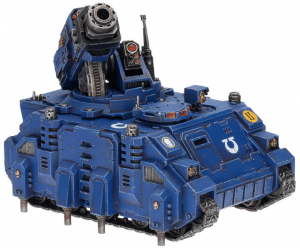
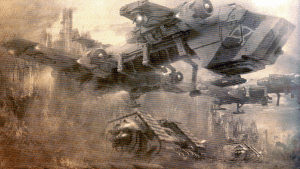
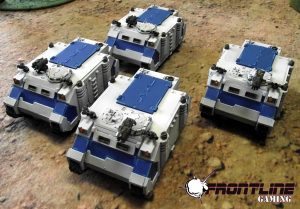
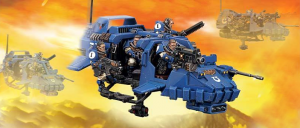
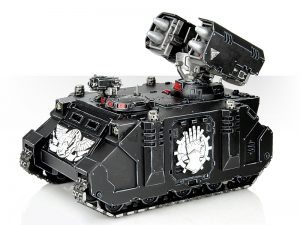
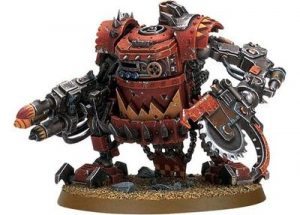
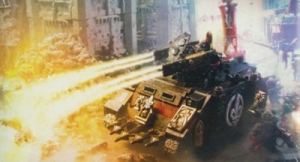
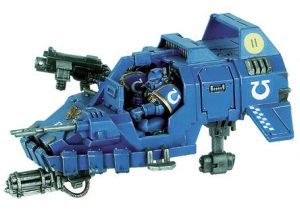
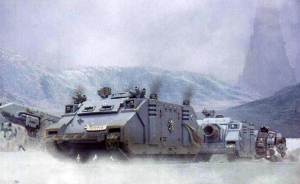
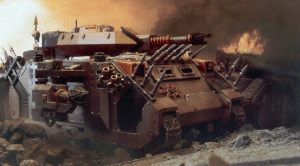
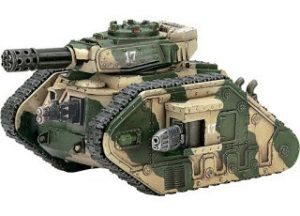
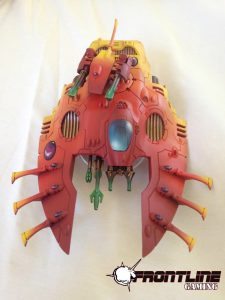
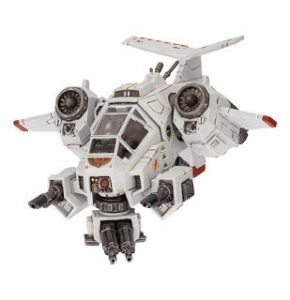
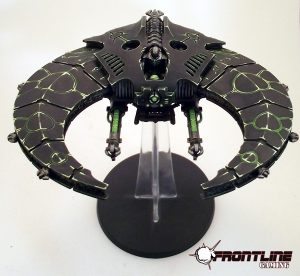
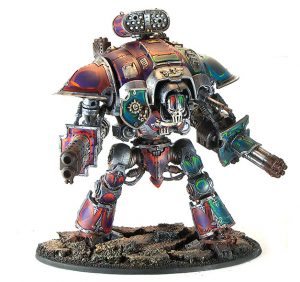
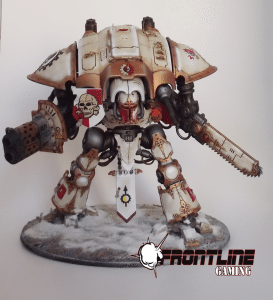
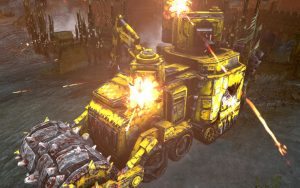
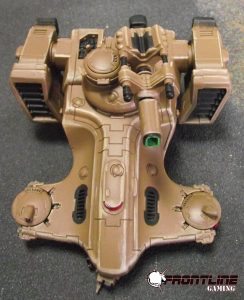
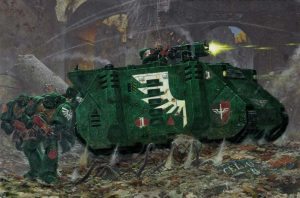
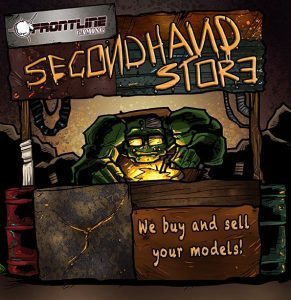
Bring back defensive weapons!!!
Honestly I think they should have gone the other way with glancing hits and let them roll vehicle damage (but be unable to wreck/explode without bonuses) but not shave off any hull points.
Excellent historical overview ! I think grav is way too powerful and should only cause crew stunned results or not be ap2. Being so amazing versus every type of unit makes for lack of
variety. If GW toned down grav they’d sell more vehicles!
Which begs the question does the land raider spearhead ignore the graviton Immobilized result?
The spearhead will ignore the immobilised results.
However, the recent draft FAQ stated that a vehicle suffering 2 successive “wounds” from grav took 3 hull points damage. There was no mention of the vehicle being immobilised. I think this was to allow grav to cause more damage to superheavy vehicles, but think it would still apply to the Land Raider Spearhead. They won’t be immobilised, but will still lose the additional hull point from two successive “wounds” in the one shooting phase. At least, that is my interpretation.